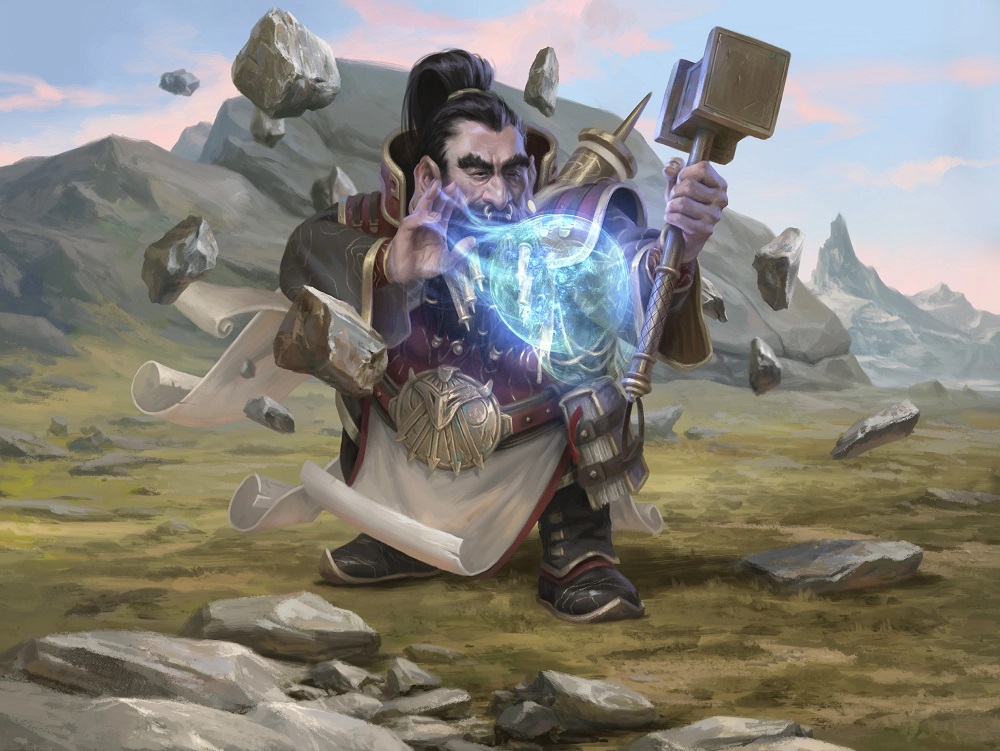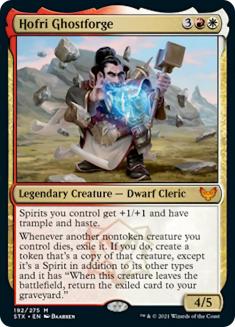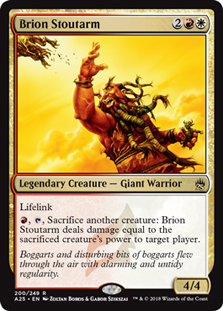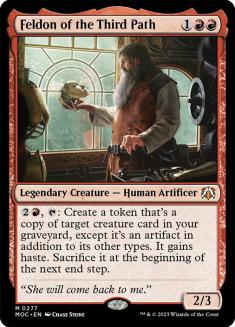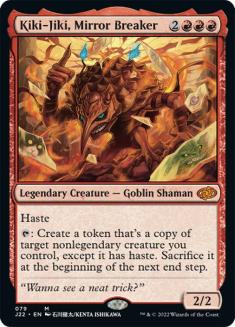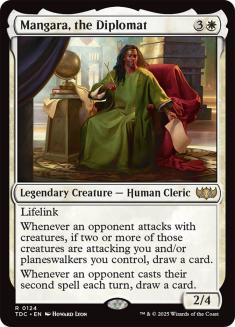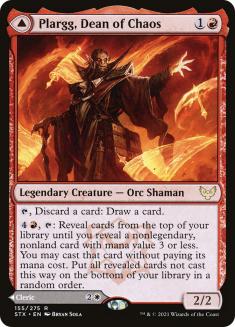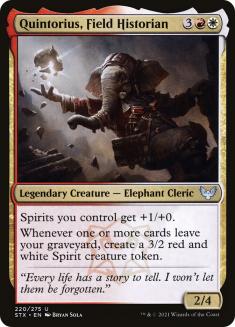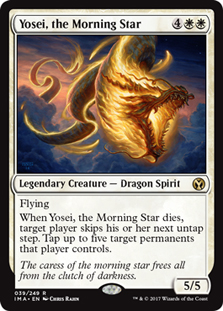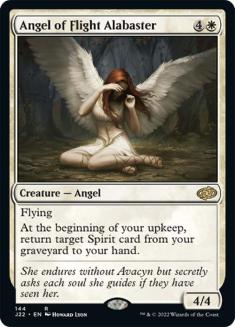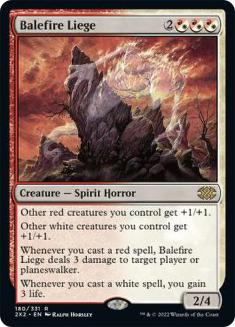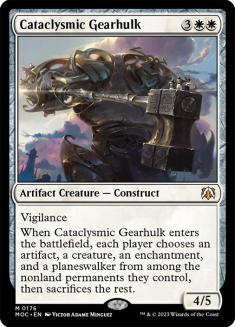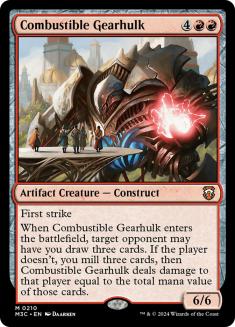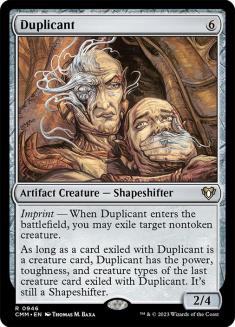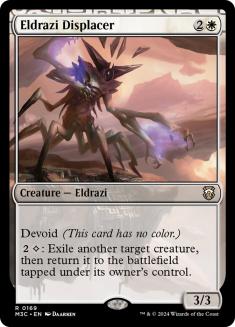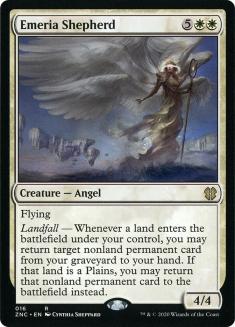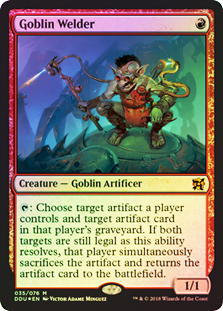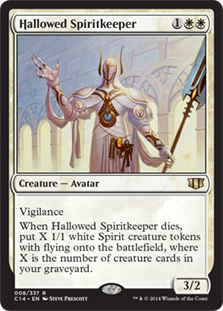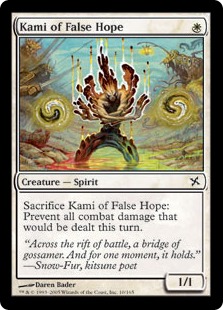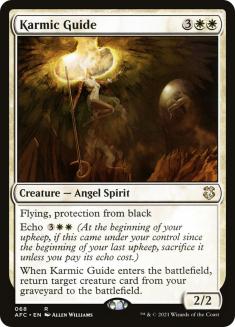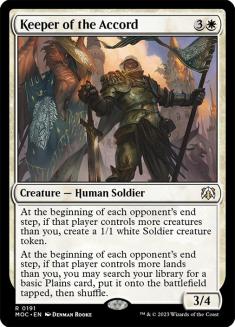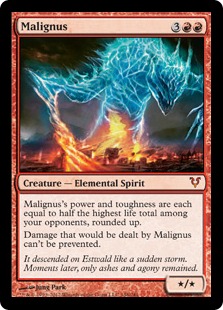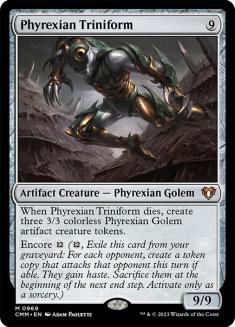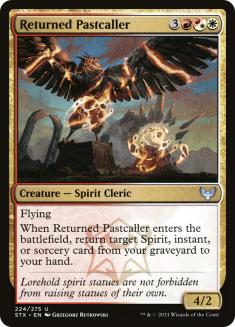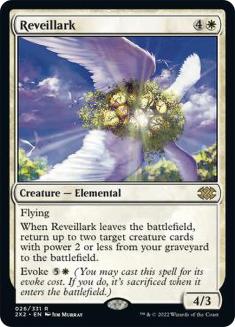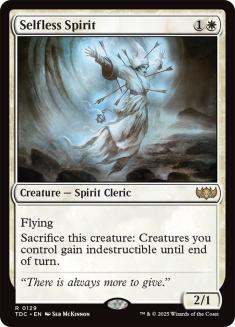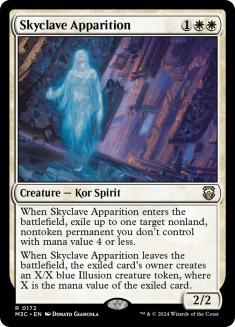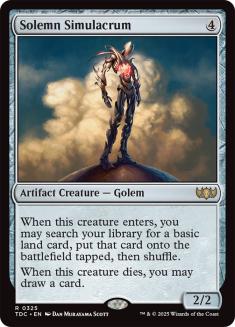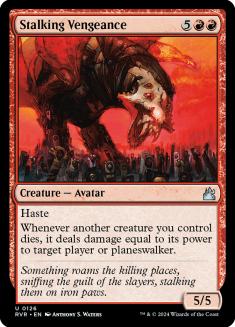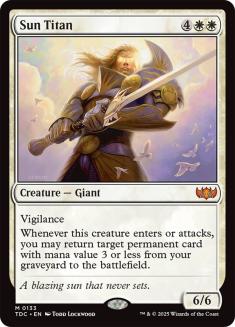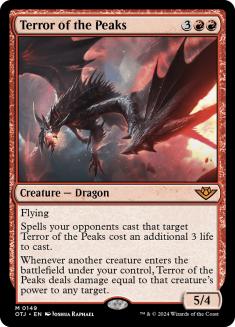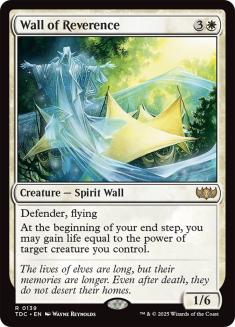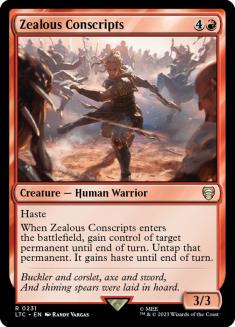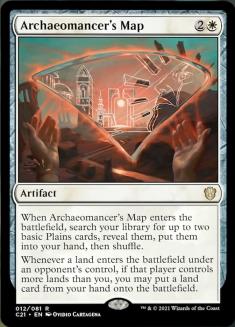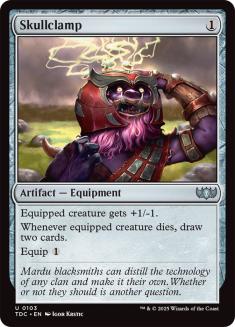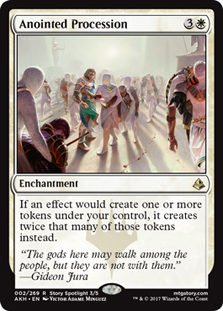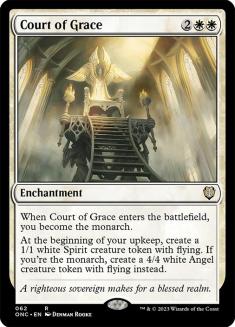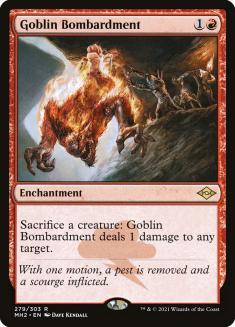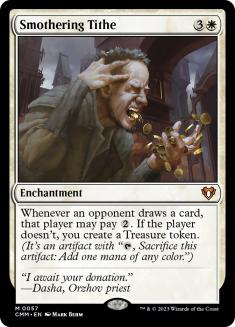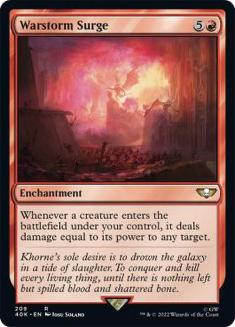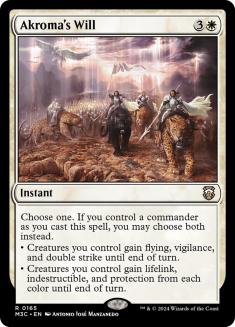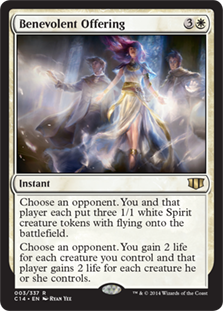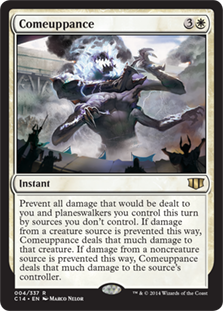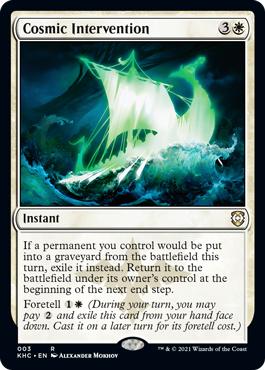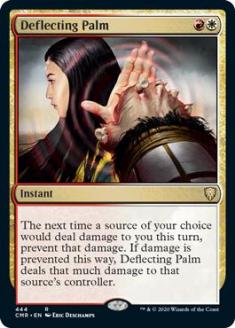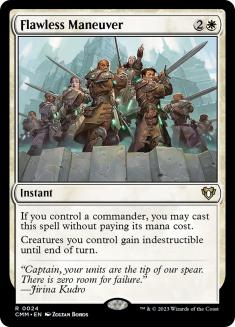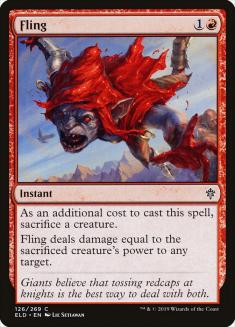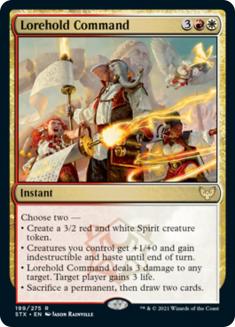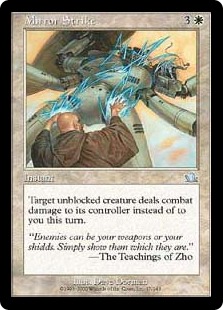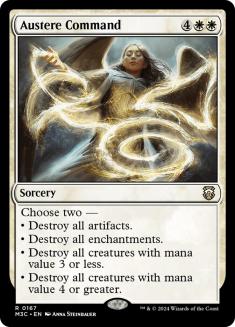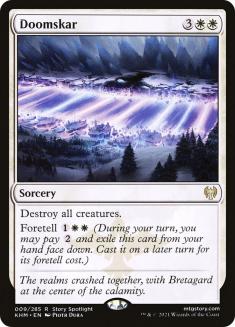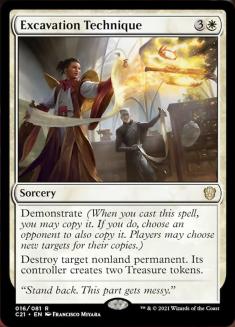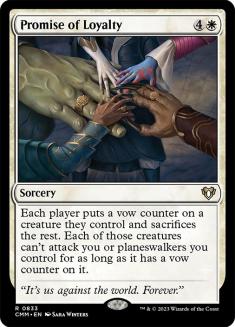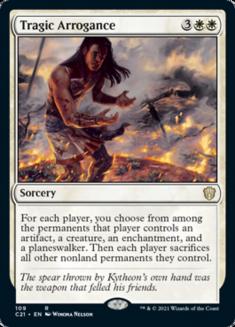Deck ideas sometimes come to you from the oddest directions. Such is the case with Hofri Ghostforge. Last week, as I discussed idea for the Elder Dragons from Strixhaven, I mentioned a Spirit tribal subtheme for Velomachus Lorehold. A few of those cards got me thinking about more of a commitment to Spirits, and a few steps later, I ended up at Hofri Ghostforge. Since it was one of the Strixhaven cards I was the most high on in the first place, it was a natural point to build from. It’s a thrilling card with some thoroughly exciting possibilities.
The primary thing about Hofri is that the token Spirits you create have trample and haste, so going tall with some real monsters — certainly something I love to do — was definitely on the table. It’s also a nice way to double up on creatures with good enters-the-battlefield triggers, although you’ll see that I didn’t overcommit to that strategy. What I did was put together a deck that could hold its own in the types of games I like to play, with some big, splashy plays alongside the odd classic finishing move. I’ll offer up the list, and then break down the cards in each section.
Creatures (33)
- 1 Kami of False Hope
- 1 Solemn Simulacrum
- 1 Serra Avatar
- 1 Kiki-Jiki, Mirror Breaker
- 1 Yosei, the Morning Star
- 1 Goblin Welder
- 1 Duplicant
- 1 Karmic Guide
- 1 Stalking Vengeance
- 1 Brion Stoutarm
- 1 Reveillark
- 1 Balefire Liege
- 1 Wall of Reverence
- 1 Sun Titan
- 1 Angel of Flight Alabaster
- 1 Zealous Conscripts
- 1 Malignus
- 1 Feldon of the Third Path
- 1 Hallowed Spiritkeeper
- 1 Emeria Shepherd
- 1 Eldrazi Displacer
- 1 Selfless Spirit
- 1 Cataclysmic Gearhulk
- 1 Combustible Gearhulk
- 1 Mangara, the Diplomat
- 1 Terror of the Peaks
- 1 Keeper of the Accord
- 1 Skyclave Apparition
- 1 Phyrexian Triniform
- 1 Plargg, Dean of Chaos
- 1 Returned Pastcaller
- 1 Venerable Warsinger
- 1 Quintorius, Field Historian
Lands (36)
Spells (30)
- 1 Sol Ring
- 1 Fellwar Stone
- 1 Goblin Bombardment
- 1 Skullclamp
- 1 Wayfarer's Bauble
- 1 Fling
- 1 Mind Stone
- 1 Mirror Strike
- 1 Boros Signet
- 1 Austere Command
- 1 Warstorm Surge
- 1 Deflecting Palm
- 1 Benevolent Offering
- 1 Commander's Sphere
- 1 Comeuppance
- 1 Tragic Arrogance
- 1 Panharmonicon
- 1 Anointed Procession
- 1 Smothering Tithe
- 1 Talisman of Conviction
- 1 Arcane Signet
- 1 Flawless Maneuver
- 1 Court of Grace
- 1 Akroma's Will
- 1 Doomskar
- 1 Cosmic Intervention
- 1 Lorehold Command
- 1 Excavation Technique
- 1 Archaeomancer's Map
- 1 Promise of Loyalty

Legendary Creatures
The deck’s commander sets up many of the other cards. The idea is to get multiple uses — whatever those uses might be — out of each creature. Sweepers will happen in Commander, and Hofri helps us profit when they do.
There are a few excessively large creatures in the deck; flinging them with Brion can both win games and keep us alive by boosting our life total. Additionally, Brion is another way of getting Hofri to trigger, perhaps setting us up to fling something again.
Since there will be plenty of creatures in the graveyard, Feldon is a cost-effective way of using them again, most often when it comes to attacking, but sometimes for their utility abilities. Because those creatures also become artifacts, they can be used along with Goblin Welder. The token is going away at the beginning of the next end step, so we can extract even more value out of it.
There’s lots of value to be had with Kiki-Jiki, Mirror Breaker, and although there are simple game-winning combos with it, I like it because there are often new lines of play with it based on the battlefield state. I happen to have Zealous Conscripts in the deck, so there’s always that option, but it’s not the method I’m counting on winning with, since there’s no real way to tutor up either of them.
Sometimes, you just put single-card value pieces in the deck, and Mangara is there simply for card-drawing.
Plargg provides rummaging value to the deck, both drawing cards and getting specific ones into the graveyard. I doubt Augusta, Dean of Order makes an appearance all that often, save maybe to provide a finishing move in combat.
Quintorius could also serve as commander of the deck, although there wouldn’t be the same kind of big, silly plays as with Hofri. It synergizes quite nicely with Hofri’s triggered ability, keeping us in lots of Spirits.
The Kamigawa Dragons are all Spirits, so both Yosei and Ryusei would fit. The latter got cut early in the build, since it would kill the commander. There’s no infinite lockdown loop here, but a few Yosei triggers (as well as attacks) might be all we need to close things out.
Creatures
Once the Spirits go back into the graveyard from the ability Hofri gives to the tokens, Angel of Flight Alabaster will be there to bring them back, ready to cast again.
There will be combats with this deck, and Balefire Liege will make our side larger. The triggered ability of casting red and/or white spells is just a bit of extra value — but don’t underestimate lifegain and damage in packages of three.
To leverage Hofri’s ability, we need some battlefield sweepers. Cataclysmic Gearhulk is particularly useful against go-wide strategies that require lots of creatures. For us, it just puts stuff in the graveyard to later bring back.
I’m a big fan of the gamesmanship that goes along with Combustible Gearhulk. Particularly in this deck, there really isn’t a good choice for the opponent; they just have to guess which one will be less bad.
Admittedly one of my favorite cards, Duplicant will do lots of heavy lifting, especially with Panharmonicon on the battlefield.
Eldrazi Displacer, aka “Blinky the Eldrazi,” has a great deal of situational value. It can be used to Fog a creature, save one of ours from targeted removal, or get an extra copy of a triggered ability.
One of the fewer high-cost cards in the deck, Emeria Shepherd’s value is clear in a deck that really enjoys having stuff in the graveyard, especially with seventeen Plains in the deck.
There are so many shenanigans possible with Goblin Welder, it’s probably too hard to list them all. As already mentioned, it gives us something to do with those tokens Feldon creates before they go away. It also presents us with options for Treasure tokens if we don’t really need the mana. And there are always routes to dagger an opponent, switching their good artifact on the battlefield for a worse one in the graveyard.
One of the Spirit-adjacent cards I mentioned with Velomachus Lorehold, Hallowed Spiritkeeper helps rebuild our battlefield state after a sweeper, providing a viable army once Hofri returns, or just making lots of nice Goblin Bombardment fodder.
Remember, kids: Stay in school, eat your vegetables, and play your Fogs.
It turns out that you can be both an Angel and a Spirit. What’s nice with Hofri on the battlefield is that when you don’t pay echo for Karmic Guide, you get the token copy with its trigger, and then when you don’t pay the echo on that one, Karmic Guide comes back into the graveyard.
I really just want to squeeze some value out of Keeper of the Accord and Emeria Shepherd.
Because Malignus is a Spirit, Hofri gives it haste and trample, which could lead to quite a bit of damage when it first hits the battlefield.
This thing is 100% in the deck because of Goblin Welder. It could conceivably come out on an early turn if it were rummaged away. Regardless of when it appears, it will be scary.
It’s a little pricey, but getting multiple uses out of Returned Pastcaller’s very flexible ability is where it’s at.
No infinites here, just lots of great value with Reveillark plus Hofri.
Although this deck likes stuff in the graveyard, sometimes we’ll want to protect the things on the battlefield, especially if one of them is the commander.
Serra Avatar is here primarily to go alongside Wall of Reverence, doubling our life total every turn. Serra Avatar really can’t end up in the graveyard for long, since it has a triggered ability to shuffle it back into the library. With Hofri on the battlefield, though, we now have two triggers when Serra Avatar hits the graveyard. We can stack them so Hofri’s resolves first, giving us a giant, hasty, tramping Spirit token with power and toughness equal to our life total. If we don’t succeed in killing people with it, Serra Avatar will come back into the graveyard when the token goes away, which will lead it to get shuffled back into the library.
The best use I’ve found so far for Skyclave Apparition is taking out problematic artifacts and enchantments, eventually giving the opponent a creature with no abilities. I suspect it’s going to do much of the same in this deck.
Some people say that Solemn Simulacrum is no longer good in Commander. Those people would be wrong.
While I’ve tried to keep the mana value of the cards in this deck a little lower, Stalking Vengeance is a concession that I’m happy to make. It’s going to be doubly effective in this deck, as my creatures basically die twice. I look forward to seeing this and Serra Avatar on the battlefield at the same time.
Except for Panharmonicon, Sun Titan will bring back every artifact in the deck. It’ll also pick up a fair number of the creatures. I’ve moved away from playing Sun Titan in some recent decks because I felt like I was going to the well too often. It just seemed like a natural fit here.
If you’re going to have lots of creature enters-the-battlefield triggers, you might as well also have them deal damage. Once again, resolving Serra Avatar will be quite something.
An alt-Sun Titan, Venerable Warsinger only gets back creatures, but since it’s likely to be larger due to Hofri, it can get back ones with a higher mana cost.
We sometimes underestimate life gain in Commander, and Wall of Reverence is here to show folks the error of their ways.
Even without the Kiki-Jiki combo, Zealous Conscripts is just a solid card. In this deck, we’ll get extra triggers from either Panharmonicon or from creating the Spirit version.
Artifacts
I don’t need to break down all the mana rocks, save to note that Mind Stone and Talisman of Conviction are both intended to fuel Eldrazi Displacer.
The Map is conditional ramp, but that’s what we’ve come to expect in white; it’s good design space. Getting those two Plains also helps us move towards our Emeria, the Sky Ruin threshold.
Whether it’s returning to creatures from the graveyard with Karmic Guide or doubling up the damage from Terror of the Peaks, Panharmonicon is going to pay great dividends in this deck.
One of the primary card draw engines in the deck, Skullclamp will give us something to do with the smaller token Spirits, assuming Hofri isn’t on the battlefield. Even if he is, there’s always Goblin Bombardment.
Enchantments
What’s better than one, big, tramply, hasty token? Two! Instead of how Anointed Procession is normally used—big, splashy value—I’m more in for just a little bit of incremental advantage. Sure, if we get to create two Terror of the Peaks tokens, it’ll be on, but that’s the outlying case, not the primary use one.
I found Court of Grace in search of Spirit token-makers, but I stayed with it for the monarch. I’m still running with the idea of introducing the mechanic into the game, letting someone else take it, and then have the other three players fight over the rest of the game. Theoretically, the damage they deal to each other will be worth more to us than the occasional card. The secondary effect is that we’ll be taking less damage ourselves over the long run. Add to that, we have some You Did This to Yourself elements, and there’s plenty of interplay.
It’s one of my favorite cards, mostly because it’s a zero-cost sacrifice outlet. The one damage is nice and all, but’s really just a cog in any number of engines. Of course, when Stalking Vengeance is involved, that damage is more than just nice.
To be fair, I would have been just as happy with something less expensive mana-wise that created fewer Treasures every turn cycle. Sure, we’ll use them to fuel spellcasting, but the cooler thing will be to trade one in for Phyrexian Triniform via Goblin Welder.
Sometimes, you just have to deal damage. Just like I mentioned with Terror of the Peaks, doubling up due to Hofri is going to lower life totals in short order.
Instants
I’m not a fan of auto-includes, but this thing is so good. It’s flexible enough to give you both offensive and defensive options. Even if you don’t control your commander, choosing the mode that makes your creatures indestructible will get you out of a tight spot. In this deck, the offensive option is most likely, as there will definitely be times we’d rather our creatures hit the graveyard.
The kind of political card I like, Benevolent Offering isn’t quite as symmetrical as it seems, since our Spirits will be bigger due to cards like Quintorius, Field Historian and Hofri.
You Did This to Yourself elements have become my signature move, and Comeuppance is a major player. It just makes me wonder if I should be playing Repercussions at well.
While we do want our creatures eventually hitting the graveyard, there are times when we’ll want to protect them. Unlike cards that give creatures indestructible, Cosmic Intervention will let us double up on any enters-the-battlefield triggers. Foretelling it protects from hand destruction and spreads the cost over multiple turns.
Deflecting Palm is to turn back something big onto its controller, whether that’s an immense creature or a big direct damage spell—especially in these days that have cards like Fiery Emancipation and Crackle with Power.
About the only creature we don’t want hitting the graveyard is Hofri himself. Flawless Maneuver will protect him (as well as the rest of the team) for zero mana.
With a very large creature, Fling can be lethal. Unfortunately, then that creature is gone. With Hofri, a copy of that creature comes back in order to deal out more beatings.
I suspect the two most frequent choices here will be the indestructible and card draw modes, especially since the latter will be a creature that Hofri will do its thing to. I also suspect that Lorehold Command costs five instead of four due to Sunforger.
The first time I ever played Mirror Strike, someone was attacking me with a 49/49 Omnath, Locus of Mana. They unfortunately didn’t have a mana sink. I’ve been a big fan of the card ever since, as it’s also killed someone who attacked with a Blightsteel Colossus.
Sorceries
Flexibility is the key with Austere Command, and it’s the reason that it’s been a favorite card in the format for a very long time.
What I like about a battlefield sweeper with foretell is that it’s cheaper to cast later, meaning you have more resources available to rebuild your battlefield.
Definitely a political card, Excavation Technique will get rid of three problematic permanents, so long as you can get someone to agree with you. Since most folks can agree what the table’s primary threats are, it should be pretty easy.
One of the cards I designed, Promise of Loyalty is the friendly battlefield sweeper. Everyone is going to keep their best creature, and the vow counter will keep them off your face. In this deck, the one we keep will clearly be Hofri, so that he can continue making Spirits.
Another way to get rid of lots of stuff without potentially crippling yourself, Tragic Arrogance lets you pick what everyone gets to keep, meaning you’re definitely going to end up with better stuff.
The Spirit of Hofri is a deck that takes a different approach to what the colors normally do together. There are a few obvious win conditions, but for the most part it’ll be up to the pilot to navigate their way through the challenges and dangers of the other players and the battlefield. I’ll be playing it on the Commander RC stream at the first opportunity.
Visit my Decklist Database to see my Signature Decks, the Chromatic Project, and more!

